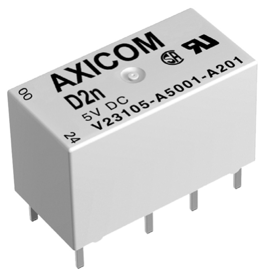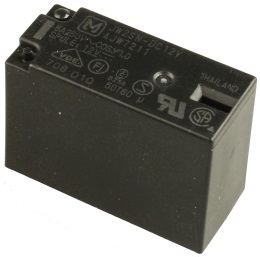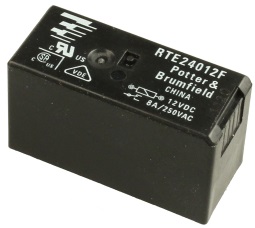Fusion Expansion DPDT Relay Controller 32-Channel
Highlights
- 32-Channel DPDT 1, 3, or 5-Amp Relay Expansion Board
- DPDT Relays Include 6 Connections per Relay
- Mix and Match Different Relay Expansion Types
- Compatible with all Fusion Series Controllers
- Connects to the Fusion FXR Relay Expansion Port
- Control Up to 256 Relays Using the FXR Expansion Port
- On-Board Relay Status LEDs Indicate On/Off Relay Activity
- 12 Volt DC Operation Requires External Power Supply
- Powered using a 2.1mm Barrel Connector or Screw Terminals
32-Channel DPDT Expansion Controller for Fusion Series Controllers
This Fusion 32-Channel DPDT Relay Expansion plugs into the Fusion FXR Relay Expansion Port to add more relays to your Fusion series dual interface relay controller. This controller includes 32 LED status lights and 6 connection points per relay. This expansion may be powered by a 2.1mm 12VDC barrel connector or via screw terminals for direct wired power installations. On-board switcher regulator power supply runs cool and provides plenty of power for the logic of this design. FXR expansion input and output connectors allow it to mix anywhere on the chain of relay expansion boards. Mix different types of relays as your application requires.
Fusion Expandability
Fusion Controllers know how to expand. Easily add Analog to Digital Converters, Contact Closure detectors, I²C devices, and a wide variety of sensors to meet your application objectives. The FXR Expansion Port allows you to also add expansion boards and control up to 256 relays.
Fusion Series Relay Controllers know how to connect to your application. With a simple point and click configuration, you can read a variety of sensors in just a few minutes. Fusion will automatically monitor your sensor in the background and make relay control decisions if a sensor is tripped or goes outside an acceptable range.
Fusion Series Controllers have 16 programmable I/O lines, which may be used for contact closure input, digital input, digital output, 8/10-Bit Analog to Digital Conversion, or I2C expansion. In most cases, these features may be mixed and matched as your application requires.
FXR Expansion Port
FXR Relay Expansion Controllers add a large variety of relay switching capabilities to an existing NCD Fusion series controller.
The FXR Expansion Port is used to add banks of external relays to a Fusion Controller. As we continue to develop new devices, a modular architecture will be implemented, offering the greatest amount of user flexibility.
Controlling FXR Expansion Banks
FXR Expansion Boards have no on-board brains. They are entirely reliant on the brains of a “master” Fusion device. The FXR Expansion Modules have many possibilities:
- Adds up to 256 Relays to a Fusion Series Controllers
- Mix and Match Relay Types to Suite your Application Needs
- Choose Between Mechanical and Solid-State Relay Types
- Choose DPDT Relays for Signal Switching Applications
- Automate All 256 Relays for Automatic Control using Base Station
Linking FXR Expansion Boards Together
FXR Expansion Controllers consist of a FXR Input and FXR Output Connector. Simply connect the FXR Output of your Fusion Controller to the FXR Input located on the relay expansion board. Chaining more relays is easy. Simply connect the FXR Output of your Fusion expansion board to the FXR Input of your next relay expansion. Mix and Match different relay types as your application requires.
We always include the 6″ expansion cables with your expansion board. We can provide longer cables if needed, but it’s important to keep the cabling as short as possible. Not all users will be able to expand to 256 total relays, as it all depends on the installation, the amount of electrical interference, and the overall cable length. For best compatibility, the total length of the Fusion controller and all of the expansions and cabling should not exceed 1 or 2 meters.
Associated Part Numbers
This product may have been previously manufactured using a part number shown below:
Relay Options

1-Amp DPDT Signal Relay Option
This controller offers an optional 1-Amp small signal relay, allowing control of low-power telecommunications signals up to 12VDC at 1 Amp. Ideal for audio, telecommunications, and very low power switching applications. This relay has a low On resistance. The 1-Amp signal relay is of the DPDT variety, which is the same as two SPDT relays that switch simultaneously, but remain isolated from each other. This relay has 6 total user connections, two of each of the following: Common (C), Normally Open (NO), and Normally Closed (NC). Common is connected to NC when the relay is off. Common disconnects from NC and connects to NO when the relay is activated. All connections are made via screw terminals, capable of accepting up to 16 AWG wire. Review Datasheet

3-Amp DPDT Signal Relay Option
This controller offers an optional 3-Amp small signal relay, allowing control of low-power telecommunications signals up to 12VDC at 3 Amps. Ideal for audio, telecommunications, and very low power switching applications. This relay has a low On resistance. The 3-Amp signal relay is of the DPDT variety, which is the same as two SPDT relays that switch simultaneously, but remain isolated from each other. This relay has 6 total user connections, two of each of the following: Common (C), Normally Open (NO), and Normally Closed (NC). Common is connected to NC when the relay is off. Common disconnects from NC and connects to NO when the relay is activated. All connections are made via screw terminals, capable of accepting up to 14 AWG wire. Review Datasheet

5-Amp DPDT Signal Relay Option
This controller offers an optional 5-Amp signal relay, allowing control of signals up to 12VDC at 5 Amps. Ideal for audio, telecommunications, and light-duty power switching applications. This relay has a low On resistance. The 5-Amp signal relay is of the DPDT variety, which is the same as two SPDT relays that switch simultaneously, but remain isolated from each other. This relay has 6 total user connections, two of each of the following: Common (C), Normally Open (NO), and Normally Closed (NC). Common is connected to NC when the relay is off. Common disconnects from NC and connects to NO when the relay is activated. All connections are made via screw terminals, capable of accepting up to 14 AWG wire. Review Datasheet
Wiring Diagrams
Introduction to Relay Control
This video will guide you in determining which relay controller you need for your application as well as a general overview of the differences between Relay Options. If you’re new to our products or just need a refresher for a new application this is a great place to start.
Induction Suppression
Learn about Induction and how it comes into play with Relay Controllers. Induction suppression can make your Relay Control applications intermittent and unreliable. This video will show you what causes it, how to avoid it, and how to account for it in your application.
FXR vs. XR Expansions
FXR and XR expansions are very similar, but are not directly compatible with each other. The FXR expansion port is an updated version of XR, which includes a right-angle connector to support our metal enclosures. The FXR cable is also capable of carrying I2C data. Because of the right-angle connector, the polarity of the cable is not compatible with XR expansions.
Maximum Relay Rating Notes
Fusion is capable of expanding to an absolute maximum of 256 Relays. In some cases, it may not be possible to control all 256 relays, particularly in applications where high noise levels may be involved. Experimentation may be required, as it is not possible for us to guarantee all users will be able to utilize all 256 relays in every application. Noise tends to accumulate when several expansions are connected together. For best results, the FXR expansion cables must be as short as possible. The typical total length of Fusion and all of its expansions and cabling should not exceed 1 or 2 meters.


